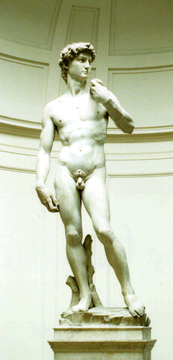article
In Flagrante: Shock Art and Dirty Politics
MAY 10, 1996
Shock art in today’s culture.
Freedom of expression and libidinous license frequently get confused in modern-day art and in our political discourse. This confusion is a ripe subject for satire. It is also a Postmodern condition that will not go away. The arts (and their increasingly competitive markets) more and more resemble electoral politics (and their increasingly deceptive campaign strategies) and both avant-garde shock artists and presidential candidates are falling helplessly into the maw of consumer marketing.
In The Naked Eye, Paul Rudnick satirizes the absurdly symbiotic “scene” within which exhibitionistic shock artists make lucrative careers out of provoking righteous indignation, while worldly-wise politicians (who mask their own rampaging libidos) make lucrative careers out of surfing the waves of public indignation.
The salutory instinct for satire is kindled by situations such as ours. We are obviously immersed, at the tail end of this turbulent and savage century, in a deliberate culture of saturation advertising that assaults every conscious moment of our urban lives. Pushing each other’s “hot buttons” is a strenuous full-time pursuit in just about every modern profession (it is hard to think of any profession any more that doesn’t define itself in terms of a “product” it must “sell”). The extremes to which we seem driven in our continual efforts to get and hold each other’s attention can, in a certain light, make us laugh, but eventually our extremes must give us pause. Violent terrorism is emerging all too apparently as the ultimate term of our pathological need to break into each other’s consciousness and prevail there. Most satirical farce imitates the rising tempo of such a logic of insanity, revealing a sort of crescendo ad absurdum.
The Naked Eye captures the inner mechanism of careers based on publicity and marketing. Within the art scene, prudish recoil from prurient display is a predictable response. It might even be called the “normal” reflex the typical outré avant-garde artiste is counting on when he (or she) goes mainstream.
The shock of the response is the point of the display, and the certainty that the one will provoke the other is the basis of the Shock Art aesthetic. Shock Art ambushes our sensibilities, and to the extent that it shocks us, it proves that we still have sensibilities.
But the continuous marketing of shock art is a strenuous job. Shocks wear off, just as consumer wants and desires do, and repeatedly re-kindling desire after repeated satiation requires increasingly higher voltage in the shock meant to revive the response reflex. Sex, of course, provides the master metaphor for the perpetual re-kindling of exhausted desire. And fashion–whether in clothes, automobiles, political attitudes, do-cuts or cuisine–is the master typology of the consumer cycle. Satiation (and boredom) is the paradoxical outcome of the successful consumer cycle; it is also the perpetual re-starting point. Everything must be superseded, and with such absurd demands upon it, imagination itself will boggle at the dizzy prospect of perpetually re-inventing the ever-new. Non nova, sed nove (not new but novel) was already a Latin proverb in antiquity.
And this is where politics and politicians complete the picture. Feeding equally on public response, on the illusion of renewal, politicians attack public apathy less and less with new ideas, and more and more with novel gimmicks calculated to whip up an ephemeral public enthusiasm. The great motto of satire has always been the castigat ridendo mores of the comic muse: she corrects our moral perspective through laughter.
Robert Scanlan is the Literary Director of the American Repertory Theater.

